 "Augustine" is a table grape variety, which even a beginner summer resident can grow. Unpretentious plants withstand the unfavorable climate and are able to produce crops in not very comfortable conditions. Such quality varieties attract professional winegrowers.
"Augustine" is a table grape variety, which even a beginner summer resident can grow. Unpretentious plants withstand the unfavorable climate and are able to produce crops in not very comfortable conditions. Such quality varieties attract professional winegrowers.
Content
Description and characteristics of the variety
Growing "Augustine" on an industrial scale is possible only in the southern part of Russia. The ideal conditions for cultivation is the temperate continental climate of the Krasnodar Territory. On a small scale and for their own needs, on the personal plots and vegetable gardens, the variety is successfully grown throughout the country. Early ripening and good frost resistance make it possible to obtain abundant harvests even in the northern regions.
Ripening period of "Augustine"
Ripening speed is one of the main advantages of Augustine. The ripening period is very short, only 115 days, this characterizes the variety as ultra-mature. If spring arrives on time, without delay, then you can collect ripe berries in the month of August.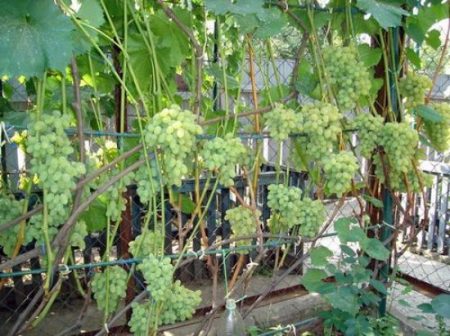
The characteristic features of the grape tree
Plant "Augustine" is a powerful and vigorous perennial vine. Therefore, it is often planted by gardeners not only for berries, but also for decorative purposes. The ability to grow quickly is used to decorate green arbors or decorate verandas. The vine has a noble red-brown color, but it is difficult to consider for a large volume of dark green mass of large leaves. The leaf plates have a beautiful almost rounded shape with three barely distinguishable blades. The lower surface of the leaves is slightly pubescent; the upper surface is even and smooth.
A powerful bush well forms new shoots that quickly take root, mature well and form two inflorescences. The flowers of Augustine are bisexual, therefore the variety bears fruit well without pollinators. Such a strong grape tree can easily withstand a large number of berry clusters. In the fruiting period, the bushes enter already in the second year after planting.
The advantage of this variety is its excellent frost resistance, plants easily tolerate frosts up to -25 degrees.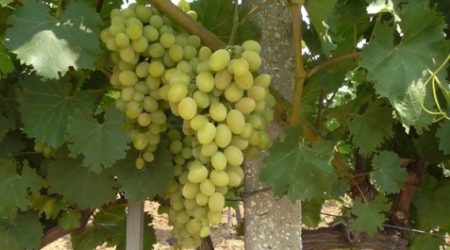
Description of berries and purpose of the variety
Berries of "Augustine" have an average weight of about 6-8 grams and an elongated oval shape. This indicates the large-fruited variety. Grapes are collected in large from 500 grams to one kilogram of conical-type clusters. Berries of mainly the same size are not very densely arranged in them, which makes the clusters look even more voluminous. The main color of the berries is white, with full maturity and in the sun, it smoothly turns into yellow with an amber hue.
The taste of "Augustine" is very harmonious, sweet, without astringency, pleasant, refreshing. The peel is strong enough, but not noticeable with food. The pulp is dense, while juicy, with the presence of 4-6 large seeds. A feature of the variety is the ability to accumulate sugar in berries up to a content of 20% in all weather conditions. This is very much appreciated in regions where the sun is not a frequent visitor.
The dense structure allows you to transport berries over long distances, without loss of taste and marketability.Due to this property, in combination with frost resistance, Augustin grows in almost every professional vineyard.
Gardeners use berries mainly for fresh consumption, as well as for the preparation of various berry treats. The unique taste is obtained by adding "Augustine" in compote assorted. Compotes from pure grapes of this variety are boiled without sugar or with the addition of a small amount of honey, this makes the drink even tastier and healthier. And of course, every gardener knows that it is easy to make excellent white wine from table grapes at home.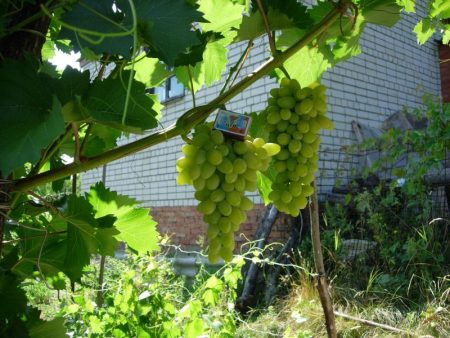
Productivity
Productivity of the variety is very high regardless of the region of cultivation. Plants have excellent plasticity and adapt to any, not even the most favorable living conditions. On average, one adult bush yields about 40 kg. But according to gardeners, sometimes more than 60 kg. When grown for industrial purposes, from one hectare of vineyard it is possible to get about 130-140 centners of marketable berries.
Advantages of Augustine grapes
- grapes enter fruiting in the second year of planting;
- the variety is unpretentious to the composition of the soil and climatic conditions;
- good resistance to low temperatures and fungal diseases;
- large size of berries and bunches;
- excellent taste and marketability;
- precocity
- grapes are stable and rich in fruiting.
The disadvantages of grapes "Augustine"
The subtleties of agricultural technology
Subject to the rules of planting and care, the Augustine bush is able to grow and bear fruit for more than 50 years in one place, without transplanting.
Landing rules
You can plant Augustin seedlings from the first days of May or in the fall, a month before the expected onset of frost. Vine grapes secrete a sunny and sheltered from the wind place. The plant will grow most comfortably near the south wall of the house and another building. In this case, most of the day the grapes will be in the sun.
The variety is not whimsical to the composition of the soil and can grow in any areas. An exception are wetlands and saline soils. Ideal for grapes will be fertile and loose soil. Such qualities can be achieved by introducing various materials, for example, sand or humus.
They dig a planting pit two months before planting. It should be about 90 cm wide and about one meter deep. At the bottom of the pit, a drainage layer (broken brick, crushed stone) must be laid out. Then set the watering pipe. For this, a plastic cut about 1.5 meters long is suitable. One end of the pipe should stand on the drainage layer, and the other remain, protruding above the ground.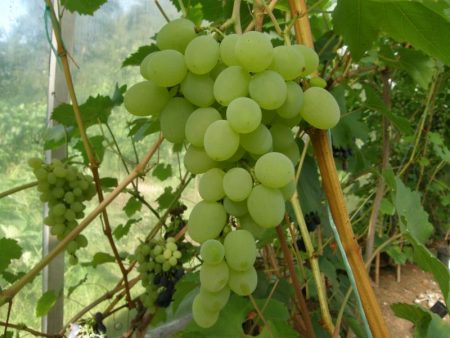
The pit is filled with nutritious soil and left for a while, so that the earth settles naturally. After time, begin to plant grapes. Already well-rooted and deepened to the right level seedlings with a large lump of land are on sale. Therefore, when planting, you just need to maintain the correct location of the bush relative to the level of the soil surface.
The final stage of planting is compaction of the soil and watering the seedling (1 bucket of water).
Vineyard care
In the first year of planting, grapes are watered in a superficial way, irrigating the trunk of a plant. Water consumption per bush one bucket. Water should be warm and settled. Starting from the second year of planting, you need to water the bush through the installed watering pipe. This method of irrigation causes the root system of the grapes to go deeper into the ground, which means it protects the plant from freezing. The watering rate is increased to two buckets, which are poured in several stages.
Fertilizing is an important and necessary procedure. A powerful plant will quickly take all nutrients from the soil and, in the absence of top dressing, will begin to experience a deficiency of trace elements. The berries will first become smaller, and in the worst case, fruiting may stop. In addition, a starving culture is most susceptible to disease and insect attack. Fertilize the soil in the vineyard from the third year of planting. Experts recommend sticking to the following scheme: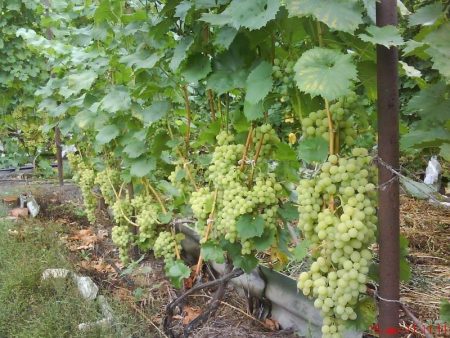
- in early spring (early April), the bushes are watered with a solution of superphosphate or slurry;
- before flowering, substances similar to the first top dressing are used;
- after flowering, ammonium nitrate is introduced in dry or liquid form;
- in the autumn months (after harvesting) grapes are fed with complex mineral fertilizer.
Bush formation
Form a bush "Augustine" should begin with the second year of planting. In the middle of the summer season, pinch the shoots, leaving 5-6 leaves on each. In the future, each gardener, based on his desires and climate conditions, chooses a bush formation scheme that is convenient for himself. This can be a fan, standard or gazebo form. At the same time, it is important to remember that the variety is prone to the formation of a large number of ovaries, therefore, to get a high-quality crop, leave no more than one brush on the shoot.
Disease Prevention and Pest Control
Grapes "Augustine" is endowed with good resistance to fungal diseases. But to diseases such as oidium and mildew, the variety still has susceptibility. Therefore, it is necessary to keep the vineyard in well-groomed form and carefully monitor the condition of the bushes. For prevention in early spring, plants are treated with sulfur solution or Bordeaux liquid.
Harvest
"Augustine" refers to table varieties, and the harvest of such grapes is carried out selectively in separate clusters as they ripen. Bunches are cut with a sharpened secateurs in dry and clear weather. You can store the fruits of this variety fresh for no more than two weeks. To do this, they are placed in wooden boxes lined with food paper and put away in a cool place.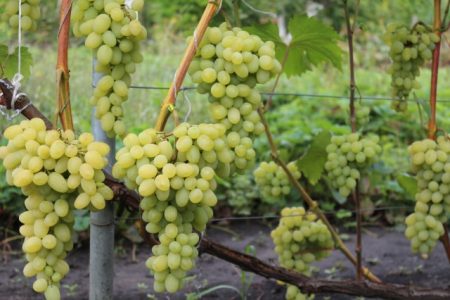
Preparation for winter
Preparation for the winter season depends on the region of grape growing. In the southern regions, where there are rarely severe frosts, there is no need to cover the vine. In regions with severe and snowy winters, the plant requires shelter. To do this, all shoots are removed from the support and carefully bent to the ground. Above the vine, you can install arcs and throw a dense spanbond on top. In addition, the vine can simply be dug up with earth, while it is important not to take the earth from the place of grape planting, so as not to expose its roots. When the first snow falls on covered bushes, an artificial snowdrift is made.
Among summer residents, there is an opinion that growing grapes on your own plot is difficult, and sometimes impossible, explaining this by the capricious nature of the culture. "Augustine" completely refutes this myth. Unpretentious in care, resistant to low temperatures and diseases, the variety will delight the plentiful harvest of even the most inexperienced summer resident.
Reviews
Albina, Yarovoye
Augustine acquired from a local winegrower.The seedling was two years old and quite developed. Planted in the spring, the first year, the bush did not really increase in size. But in the second year, in early spring, the shoots began to grow actively and each cluster formed one bunch. Berries ripened by mid-August. Taste is completely satisfied. I honestly did not expect that in our weather conditions, without much trouble, I would get a grape harvest already in the second year of planting.
Natalya, Moscow region
Excellent, high-yielding variety. Grows in our country for about six years. The bush is now very large. For him, we built a wooden trellis with six levels. In the autumn, we bend down the shoots to the ground and cover it well with fir branches, and in the spring we straighten it and tie it to a support with a fan. Bunches are formed very large at 600-700 grams, sometimes more. The berries are large, fleshy, with seeds, but very sweet and juicy. I especially like that there is no nutmeg aftertaste.

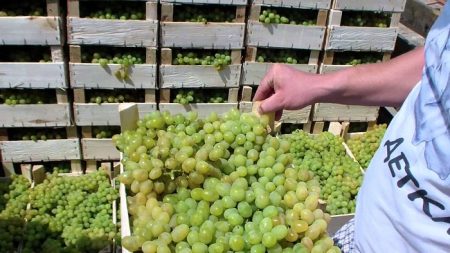



 Non-covering winter-hardy grape varieties for Moscow region
Non-covering winter-hardy grape varieties for Moscow region How to keep the vine in winter
How to keep the vine in winter When can I transfer grapes to another place in the fall
When can I transfer grapes to another place in the fall How to cover and prepare grapes for the winter in the suburbs
How to cover and prepare grapes for the winter in the suburbs